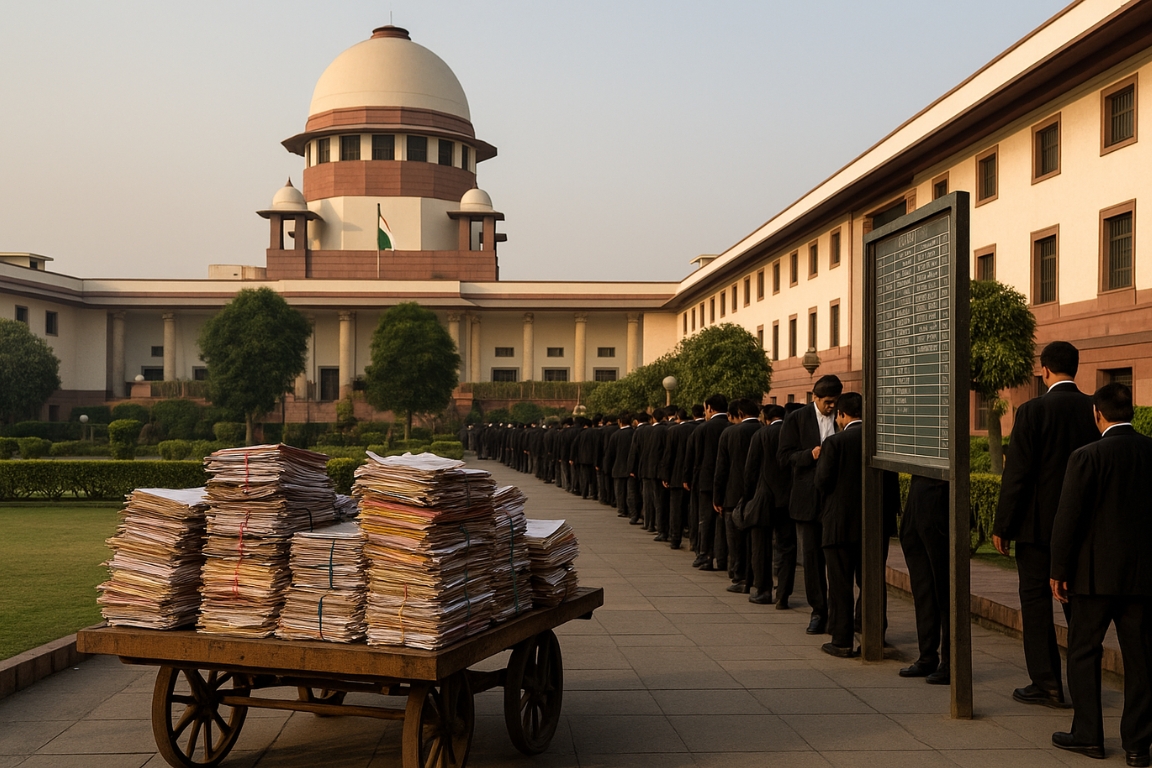The Supreme Court’s case pendency has touched an unprecedented level of over 88,000 cases, despite the court working with its full sanctioned strength of 34 judges.
Current Situation of Pendency
urrent Situation of Pendency
- As per the National Judicial Data Grid (NJDG), the SC currently has:
- Around 69,500+ civil cases pending.
- Around 18,800+ criminal cases pending.
- In August 2025, more cases were filed (over 7,000) than disposed of (over 5,600), meaning disposal was only about 80% of the fresh filings.
- The continuous rise in pendency has been observed since the pandemic years, with the number climbing steadily after 2023.

Steps Taken to Reduce Backlog
- Extended Summer Sitting: The CJI renamed the summer vacation as “partial working days”. During May–July 2025, 21 Benches heard cases in rotation to improve disposal.
- Maintaining Full Strength: Recent Chief Justices – from Justice Chandrachud to Justice Gavai – ensured the Supreme Court had no vacancies. Judicial appointments are being cleared by the government swiftly, sometimes within 48 hours.
- Increased Workload Recognition: A collegium resolution in November 2023 emphasized that even one vacancy in the SC was unaffordable due to the rising burden.
Trends in Case Filing and Disposal
- In 2025 (till September): Over 52,000 cases were filed. Around 46,000 cases were disposed of (~88% disposal rate).
- However, since filings consistently outnumber disposals, pendency keeps climbing.
- Similar trends were witnessed in 2024, when pendency had already crossed 82,000 cases.
Key Issues
- Rising Workload: Increasing volume of cases is straining judicial capacity.
- Systemic Limitations: Even full bench strength is not enough to clear backlog.
- Public Impact: Delay in justice delivery weakens trust in the judiciary.
RECOMMENDATIONS OF DIFFERENT COMMISSIONS TO REDUCE CASE PENDENCY
Law Commission of India
- Increase Judge Strength – India has fewer judges per million population compared to global standards; needs more recruitment.
- Fast-Track Courts – set up special courts for cases like sexual offences, corruption, and economic crimes.
- Alternative Dispute Resolution (ADR) – promote mediation, arbitration, and conciliation to reduce burden on regular courts.
- Case Management – strict timelines for filing replies, arguments, and adjournments.
Justice Malimath Committee (2000–2003) on Criminal Justice Reforms
- Greater Use of Plea Bargaining – to settle minor criminal cases quickly.
- Strengthen Investigations – better trained police and forensic support to avoid delays.
- Witness Protection – to reduce repeated adjournments caused by absence or threats to witnesses.
Arrears Committee (Justice V.S. Malimath, 1989)
- Curtail Adjournments – limit the number of times hearings can be postponed.
- Court Management System – better infrastructure and trained staff to assist judges.
- Prioritise Old Cases – dispose of cases pending for more than 5 years on priority.
National Court Management Systems (NCMS), 2012
- Performance Standards – set timeframes for disposal of different categories of cases.
- Court Managers – appoint professionals (non-judges) to handle administrative tasks, so judges focus only on judicial work.
- Technology Use – e-courts, digital filing, and video conferencing to save time.
Conclusion:
The Supreme Court’s ever-growing case backlog shows that increasing judge strength and extending sittings alone are not enough. Comprehensive judicial reforms, including better case management and reducing inflow of routine matters to the apex court, are needed to ensure timely justice.





